Editor’s Note: As we are building our SkiftEDU service for marketers and SMBs in travel, today we are launching a new initiative: our new weekly series on digital marketing tips and trick, what we’re calling SkiftEDU How-Tos. These How-Tos will be a series of free in-depth weekly articles around various topics in digital marketing, such as this one below.
In a world where our Facebook newsfeed is dominated b y promoted content and paid media, many travel brands have stopped believing in 1-1 direct communications with customers. They shouldn’t. Email marketing still works! More and more innovative techniques in collecting client data and the opportunity to send highly personalized and relevant messages have proven to be very effective for sales as well as customer acquisition and retention.
y promoted content and paid media, many travel brands have stopped believing in 1-1 direct communications with customers. They shouldn’t. Email marketing still works! More and more innovative techniques in collecting client data and the opportunity to send highly personalized and relevant messages have proven to be very effective for sales as well as customer acquisition and retention.
In terms of ROI, email marketing has always been a very successful strategy for the travel and hospitality industries when communicating with target markets. According to a 2015 study, the travel and hospitality industry has a newsletter open rate of 56.7%, which is the highest among the 17 industries polled and second in terms of click-through rates (15.2%).
Airlines, hotels and inns send out confirmation reminders prior to a trip, using the opportunity to upsell by pre-ordering extra amenities, for example. Destinations and CVBs can inform on upcoming events or best practices for meetings, while restaurants and attractions keep their fans updated on exciting new menus or exhibits taking place. Intents will vary, but email remains at the heart of an effective relationship marketing approach.
Are email campaigns already part of your overall marketing strategy?
The lifecycle of an email campaign is made up of two important planning steps to ensure maximum ROI.
1. Optimize your customer database and set up means to generate new leads (pre-campaign)
- Understand the needs of target audiences
- Define and segment audience personas
- Customize content/offers o be displayed
2. Automate and monitor each action members of the target audience perform (during the campaign)
- Welcome message upon registration
- Validation of whether or not the email is opened
- Identification of the date and time the newsletter was viewed
- Monitor how long the newsletter was read, what links were clicked, what productions or promotions were selected, etc.
Even if it remains the most high-performance marketing channel available within an integrated, overall strategy, newsletters must be properly set up to maximize their potential. What’s more: each year, you will naturally lose approximately 25% of your subscribers to your email list due to factors that are simply beyond your control, such as changes to email addresses. It is therefore in your best interest to focus your efforts on acquiring new subscribers, not just retention. Here are our top tips to prepare and send your next email campaign.
Optimize your customer database
There are many simple ways to collect the emails of your customers and prospects. One of the most effective is a newsletter signup form. Why?
“64.3% of customers subscribe to an email list to join loyalty or rewards program, 39.3% because the love the brand, and 35.2% in order to participate in a contest or draw.”
The most popular tools to create newsletters integrate seamlessly with almost any platforms, including MailChimp, Campaign Monitor, Hemingway App (view more email marketing tools here). An online form is used by 74% of web visitors, all sectors combined. Therefore, it is crucial to display it in an strategic area on your website.

Understand the needs of your audience
To get a complete picture of your target audience and personalize the content you will offer them, it is recommended that you add different fields in your form to facilitate how you segment your lists:
- Country, region
- Gender
- Travel preferences, hotel, airline
- Vacation dates, etc.

Make sure you strategically think about where people should sign up for your newsletter on your platform. For example, should it be on your promo page or blog, which would already indicate a deeper interest in your products or services? MailChimp just recently launched a recommendation tool to automatically generate complementary offers based on visitor preferences.
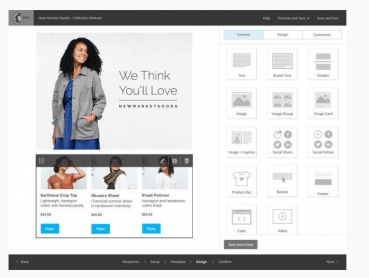 If your website is already connected to a customer relationship management system, you can use a third-party service to link up your mailing system to better segment your mailing list. Today online marketing is synonymous with uber-targeting, which means that consumers expect brands to know, from the get-go, what they are looking for. As Campaign Monitor indicates, all content must deliver the right message at the right time to the right person. Easier said than done, but it’s what your marketing should strive to achieve.
If your website is already connected to a customer relationship management system, you can use a third-party service to link up your mailing system to better segment your mailing list. Today online marketing is synonymous with uber-targeting, which means that consumers expect brands to know, from the get-go, what they are looking for. As Campaign Monitor indicates, all content must deliver the right message at the right time to the right person. Easier said than done, but it’s what your marketing should strive to achieve.
Define and segment personas
Furthermore, research shows customized emails greatly improve average click-through rates by 14% and conversions by 10%. While it’s standard to add the first name and last name to a targeted email, it’s the content and how it relates to the visitor’s interest that matters most. For example:
- Adventure, R&R or business travel
- Family, couples, singles, with or without animals
- Short-, medium-, or long-term
- Discount travel
- Turnkey experience
In the travel industry, we cannot emphasize enough the power of recommendations in customers’ purchasing process. Over 95% of travelers will read, on average, 7 comments on destinations before taking a final decision. They also spend over 30 minutes before making their reservations.
Bonus tip: Insert “view recommendations” links in your content, pointing to this sought-after section on your website or TripAdvisor page, for example.
Custom content, mobile friendly
Whether it’s for business, fun or adventure, travelers perform the vast majority of their searches on a smartphone. Over half of (53%) sent emails are opened using a mobile device and ¾ of subscribers are likely to delete emails that cannot be easily read on their mobile devices (learn more here). The majority of newsletter solutions provide an easy means to develop responsive features (that adapt to any type of screen format). However, your content must nevertheless respect certain guidelines:
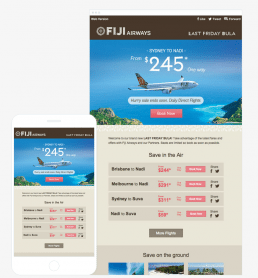
- An engaging title that incites interest, rather than June newsletter
- Email subjects with less than 50 characters or 20 characters for maximum punch on a mobile device
On average, people spend about 8 seconds on an email. Eliminate non-essential, useless words and only give the most important information up front…right after the subject line.
- Use bullet-point lists to help readers to quickly pinpoint key topics
- Offer geo-localized, personalized and contextual content and promotions with specific deadlines to stoke the sense of urgency
- High-quality images improve the credibility of the message you are trying to get across, provide a quick contextual reference, and breaks down your content so that it’s not too daunting to read
- Images could be blocked by default by various email programs; make sure you provide a text alternative so that your recipients are not inundated with blank email messages
- Maintain a 1:1 image/text ratio; if there are too many images, some filters may automatically relegate you email to spam folders
- Only use bold colors for call-to-action buttons and links that invite people to “learn more”
- Use a minimum of a 14 pt. font for your email’s body text and 22 pt. for headlines
- Avoid exclamation points, which may cause your emails to be directly sent to spam folders
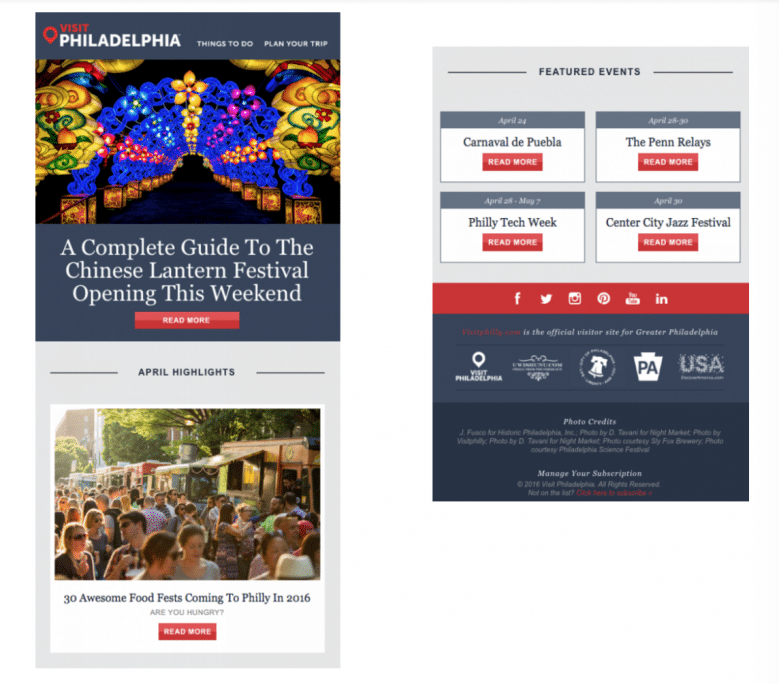
Case Study: Best Western
In April last year, Movable Ink, an e-mail marketing firm, and Best Western, the world’s largest hotel chain with more than 4,000 properties, began a three-part campaign to better optimize the 20 million monthly e-mails sent to customers. Their goals? Enhancing targeting capabilities by device and location, increasing rewards member engagement and growing revenue through hyper-targeted and relevant content.
They started by altering the e-mail creative on messaging promoting the Best Western app by using technology to identify the device on which the e-mail was being seen. Folks on an iPhone or iPad got messaging linking them directly to the Apple app store where they could download the app; those on an Android were sent to the Google Play store. The benefit? A 143% lift in downloads for non rewards-members (and 100% for rewards members) compared to similar campaigns.
Next was using geo-targeting to pinpoint a user’s location (21 were specified) and using that information to send more relevant offers.
“You would see the appropriate creative based off where you opened the e-mail,” said Ronnie Brant, director of Product Marketing at Movable Ink. “For example, if you were in New York City or on the East Coast and opened it, you would see a message promoting Florida vacations, but if you opened the same e-mail on the West Coast, you would have seen a Los Angeles-based e-mail. Their e-mail literally adapted itself based on your current location.”
The result? A 12% click-through rate jump from rewards members and a 10% improvement from non-rewards members.
(For more on this case study get the full Skift report Inbox Strategies: The State of E-Mail Marketing in The Travel Industry)
Important:
- Test your medium and your message. According to Litmus, 50.6% of companies in 2015 had to send apologies due to errors in their content
- Always add an “unsubscribe” link
- Insert your company’s email address to demonstrate credibility
- Never use misleading headlines
- Make sure visitors can share your offers; because the networks of your target audience often display similar interests, use a link generator to encourage people to share the content of your email messages on their preferred social media networks
Automate and monitor opened emails
In today’s hyper-connected world, consumers look at their mobile devices, on average, 150 times a day. As a result, the time you send your emails is no longer important. Nevertheless, you should analyze the “time” statistics in your open rates to determine the best moment to send out your newsletters or emails: on smartphones in the morning, on computers at lunch, on tablets or Apple TV in the evenings, etc.
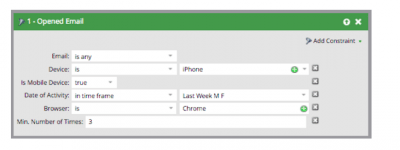
With respect to frequency, all you have to do is ask potential subscribers when they wish to receive information. If someone unsubscribes, try to find out why and rectify the situation (ex.: reduce email frequency).
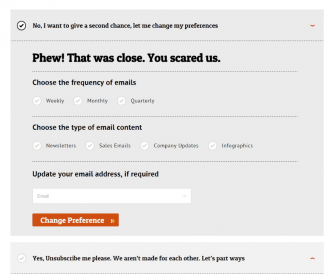
Never underestimate the importance of automatization in your email campaigns. Once new subscribers are onboard, make sure you immediately send them a welcome email based on their fields of interest.
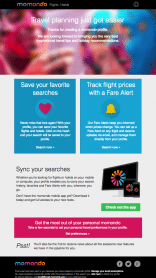
In sum:
- Determine your newsletter’s goal and profile your target audiences
- Write compelling content for each customer segment, identify effective calls to action, test, test again and send
Other ways to capture emails — both offline and online
Online
- When a customer signs up for an account
- During the online checkout process
- When customers want exclusive content
- During the installation of a company or service app
- To receive rebates
- When presenting additional options (ex.: airline security or real-time hotel availabilities each time the customer re-reads the email confirmation
- Add pop-ups on website
When it comes to pop-ups, there are various schools of thought on this. Many consider them annoying, perhaps even aggressive. Truth be told, they work… when they are well designed! Pop-ups that appear automatically upon arriving on a website are not recommended – let me read the article or consume the content I came for, please. But pop-ups can be programmed to appear after 30, 60 or 120 seconds on a site, or upon visiting at least a second page. The trigger will vary, yet this can be the difference between annoying and effective.
If and when you insert a pop-up, try to make it compelling, perhaps with a free report download or immediate 10% discount on a first reservation, for example.
Offline
- Promote keywords to text via SMS campaign, which automatically subscribe people to your email list
- If you use a tablet for payment options in store, add a link for customers to subscribe to your newsletter
At the end of the day, email remains a key component of the digital marketing toolbox, with above-index performances for travel industry stakeholders. Are you making the most of this tool to establish direct relationships and engage with your clients?
The Daily Newsletter
Our daily coverage of the global travel industry. Written by editors and analysts from across Skift’s brands.
Have a confidential tip for Skift? Get in touch
Tags: Skift EDU
